Coordination of CRC/TRR 280
Table of contents
Project data
|
Titel | Title |
Report from the annual report 2023
Ideas for new CRC designs
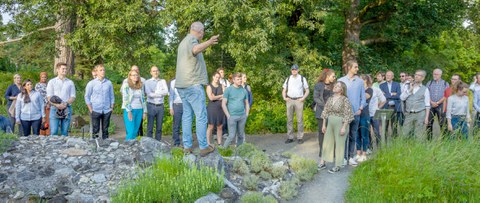
Führung durch den Botanischen Garten beim Frühjahrstreffen 2023 in Dresden
In the Collaborative Research Center/Transregio 280 (CRC/TRR 280), a highly interdisciplinary team is working on developing new design principles for carbon-reinforced concrete structures. Inspiration from botany, algebra, and art is being scientifically exploited. The material components of carbon-reinforced concrete are being researched and further developed, i.e. carbon fiber textiles, concrete matrices, and coatings for a targeted combination of textile and concrete. Research into structures focuses on shells and folded structures, material characterization and chemical prestressing, among other things. While the research into new manufacturing processes such as 3D printing and extrusion of reinforced concrete as well as the possibilities of tomography are still rather detached from the research into new constructions and members in our current work, it will be strongly linked to it in the future. The entire research is aimed at resource-saving and sustainable carbon-reinforced concrete constructions. Thus, specific methods of sustainability assessment are also being investigated.
In 2023, the focus was on preparing and submitting our proposal for the planned second funding period. To this end, many meetings were held to critically analyze our own work and develop new ideas. In addition to the regular meetings of the CRC/TRR 280, a brainstorming and idea-finding workshop “How do we design tomorrow?” was organized in Würzburg. Ideas were discussed in free association in various groups – initially irrespective of whether or not they would be usable in the future.
In numerous further bilateral real or virtual meetings, the results of period 1 were worked out more and more clearly and the remaining research gaps were identified, work plans for the planned second period were drawn up and interdisciplinary interaction between the TRR projects was repeatedly strengthened. There were also intensive discussions on how the results of funding period 1 could be demonstrated in a clear and descriptive way that would capture the essence of the research. For example, the construction of a folded structure demonstrator was started at the Institute of Structural Concrete of RWTH Aachen University. Further ideas were discussed at the fall meeting, and so a veritable “creative frenzy” was initiated in the second half of the year, which shall lead to around 50 demonstrators of varying size and complexity in the following year. This abundance of objects and demonstrators exceeded our own expectations.
Report from the annual report 2023
(A look inside - centrally supported CT examinations
Project management: apl. Prof. Dr.-Ing. Birgit Beckmann, Dipl.-Ing. Josiane Giese
Project partners: Institut für Photogrammetrie und Fernerkundung, TU Dresden | Fachgebiet Massivbau und Baukonstruktion, RPTU Kaiserslautern-Landau | Fraunhofer-Entwicklungszentrum Röntgentechnik, Fürth)
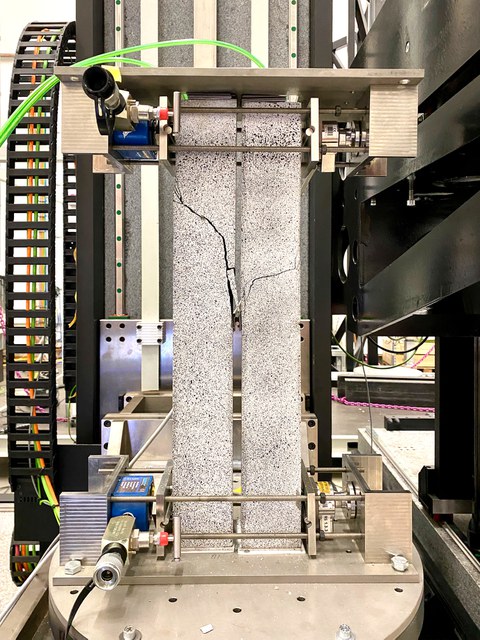
Beams after bending shear failure in 3-point bending test
Computed tomography (CT) is an indispensable method in medical technology, using a rotating X-ray tube to take non-destructive cross-sectional images of objects. But it can also be used to analyze concrete components. In addition to quality control of the production, the visualization of the interior may lead to an improved understanding of the load-bearing and deformation behavior under progressive damage. The tomography portal Gulliver – a unique large-scale CT scanner that will be able to generate high-resolution scans of concrete components with real dimensions under increased loads – is currently being built at the Rheinland-Pfälzische Technische Universität (RPTU) Kaiserslautern-Landau. Once operational, time-resolved measurements will be carried out on carbon-reinforced concrete components under various load conditions within the scope of the TRR 280.
In April 2023, first tests were carried out on carbon-reinforced concrete beams at the Fraunhofer-Entwicklungszentrum Röntgentechnik (EZRT) in Fürth, where the detector, that was later installed in the Gulliver X-ray system, was located at the time. The main aim of the bending tests was to analyze the development of cracks and determine the crack widths at different load levels. The focus was on the application of the digital volume correlation (DVC) method for the processing of the CT data. Fiber optic sensors (FOS) on the carbon reinforcement as well as digital image correlation (DIC) on the concrete surface were also used in order to verify the measurement results. DVC proved to be particularly suitable for crack widths > 0.1 mm. While the FOS and DIC were able to detect crack formation even at an early stage (< 0.1 mm), DVC did not deliver any results for these small cracks. This can be attributed to measurement noise and a lack of texture (gray scale differences) in the CT images, which, similar to surface analysis using DIC, must be present for a successful application of this method. To ensure usable measurement data for future studies on large-scale carbon-reinforced concrete samples in the Gulliver, the settings of the CT device and the configurations of the test specimens need to be adjusted accordingly.
Report from the annual report 2022
Interdisciplinary Research in the CRC/TRR 280
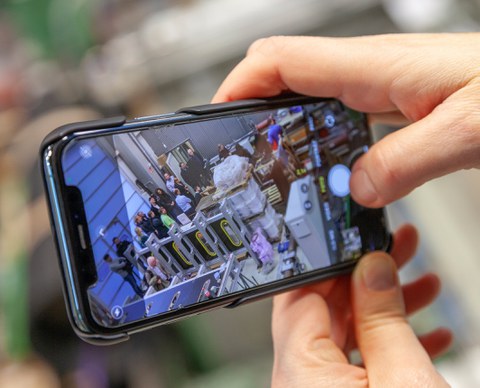
Lab tour in the OML
The central objective of the Collaborative Research Center/Transregio 280 (CRC/TRR 280) is to develop new design principles for carbon-reinforced concrete structures. To achieve this goal, scientists from very different disciplines work together in an interdisciplinary way. After the CRC/TRR 280 had been working under severe corona restrictions since the beginning of the project, real meetings of all contributors were possible for the first time in 2022. This year, two CRC/TRR 280 colloquia were held. Several laboratory tours also took place. At the spring colloquium, for example, all participants were able to visit the concrete and building materials laboratory at the Institute for Building Materials Research at RWTH Aachen University (ibac) as well as the laboratory of the Institute for Structural Concrete (IMB) at RWTH Aachen University.
At the PhD workshop “Philosophy of cognition and cross-over creativity” held in the summer of 2022, cognitive bridges were built between different subjects and, for example, the connections between mathematical interlocking and masonry arches, between truss framework constructions and textile thread running, between embroidery and binary and non-binary pixel graphics, between mathematical shelf spaces and thread graphics, and other interdisciplinary links were explored. During the workshop, basic textile techniques were not only explained, but also learned and executed in principle. Against this background, it was all the more impressive that, following the workshop, the technical center of the Institute of Textile Technology (ITA) of RWTH University with approx. 250 textile machines and test stands could be visited and insights gained into the most diverse fields and process stages of textile technology.
The Alfred-Hütter-Laboratory of the Institute for Building Materials (IfB) of the TU Dresden could be visited during the research colloquium of the German Committee for Reinforced Concrete, which took place in Dresden in September this year and where research of the CRC/TRR 280 was presented, too. At the autumn colloquium in Dresden, our Otto Mohr Laboratory as well as the carbon-reinforced concrete house “CUBE” were presented within a detailed guided tour.
In addition, there were numerous mutual exchange visits between PhD students of different subprojects from Dresden and Aachen to conduct joint research in the laboratories. If the collaboration in CRC/TRR 280 was already very good even under corona conditions, it has become even more inspiring through the real encounter at the colloquia and the mutual exchange in the laboratories and institutes.
Report from the annual report 2021
Interdisciplinary inspiration in CRC/TRR 280
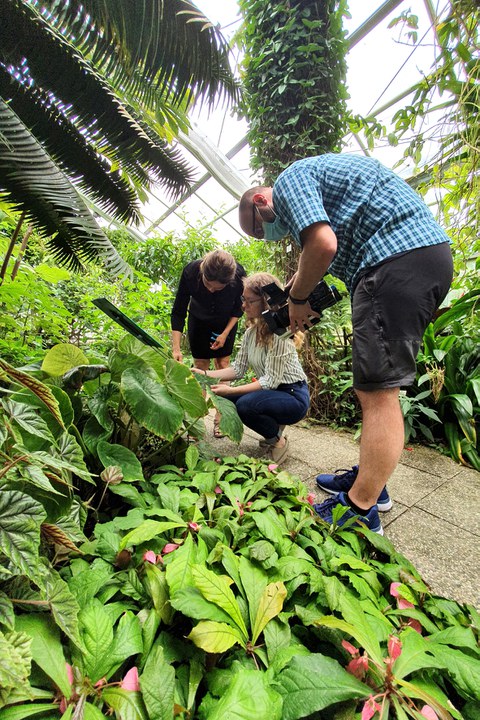
Learning from nature – Filmmaking in the Botanical Garden Dresden
Developing new design principles for carbon concrete structures is the central goal of the Collaborative Research Centre/Transregio 280. To do this, existing thought patterns need to be broken up and new, different sources of inspiration must be tapped. As an interdisciplinary approach, the CRC/TRR analyses three large, fundamental thematic complexes as sources of inspiration, which are systematised and linked with methods of knowledge architecture: botany, algebra, and and art. The aim is not only to gain knowledge for building and construction from the other disciplines but also to gain knowledge for the other disciplines through cooperation.
For example, there are parallels between plant structures and material composites such as carbon concrete. In both cases, the supporting structure consists of a composite of several materials with different load-bearing capacities, e.g. fibres embedded in a surrounding matrix. During the interdisciplinary exchange, it is found that the measurement methods are different in the respective disciplines. For example, in order to be able to classify the measured moduli of elasticity, they have to be made comparable. Differing cross-sections are used in civil engineering when calculating a stress. Thus, the full cross-section or the pure concrete cross-section without reinforcement or the so-called ideal cross-section are used. In contrast, a structural or smeared modulus of elasticity is used in botany. On the other hand, the components fibre and matrix are often not as clearly separable in botany as in concrete construction, as there is an ideally acting bond in the leaf due to the gradually different leaf material.
In the analysis of botanical structures with regard to inspiration for structural carbon concrete structures, new botanical territory has been opened up. For example, new insights were gained in the connection of shoot-forming roots or also the transition from the leaf to the stem. Ideally, principles for the bond in the carbon concrete composite can also be transferred from the gradual bond within botanical structures. By means of the bond between the concrete and the reinforcement, it is possible to control both the load-bearing capacity and the ductility of load-bearing structures.
Report from the annual report 2020
Carbon-reinforced concrete structures – inter-site basic research in CRC/TRR 280
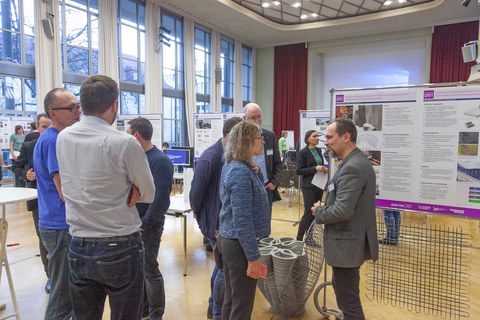
Preparation for the poster session for review of the CRC/TRR 280
The joy was enormous when the Collaborative Research Center/Transregio 280 was approved by the German Research Foundation (DFG) in summer 2020. In the CRC/TRR 280 “Design Strategies for Material-Minimised Carbon-Reinforced Concrete Structures”, scientists from TU Dresden, RWTH Aachen University and the Leibniz Institute of Polymer Research (IPF) Dresden are jointly researching principles of a new construction approach. The research concept bases on many years of preliminary work. Basic research on the new material composite textile reinforced concrete (TRC) was carried out in the Collaborative Research Centres CRC 528 in Dresden and CRC 532 in Aachen from 1999–2011, from which carbon concrete finally emerged. Building on this, application research on the material composite carbon concrete began in 2014 in the research network project “Carbon Concrete Composite – C3”. In the current CRC/TRR 280, this is followed by basic research on construction strategies with and for carbon-reinforced concrete.
Some of the scientists involved have been working together intensively for over twenty years. Other scientists – also and especially from completely different disciplines such as botany, algebra, knowledge architecture – have joined. In the interaction of different disciplines, new impulses and new ideas are to be developed to enable new types of construction and building with carbon-reinforced concrete.
While previous research focused on the material or material composite, the current research focuses on the construction. And not a single, singular or special construction, but rather the way of constructing. The new material composite, with its excellent material properties, makes it possible to build highly load-bearing and at the same time filigree structures. Nevertheless, up to now the way of constructing and the constructive realisation of components have been carried out according to classical patterns. Indeed, the lower concrete cover required for carbon concrete compared to reinforced concrete means that concrete can be saved. However, to reveal the full potential of the material composite carbon concrete and to enable highly load-bearing structures designed following the load and the material, existing thought patterns must be broken up, new sources of inspiration must be tapped, completely new ways of constructing must be found and new principles of construction must be explored. This is the declared aim of the CRC/TRR 280. And the fact that work on this ambitious aim has now begun is a cause for joy, indeed.
